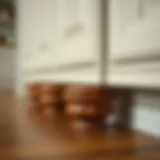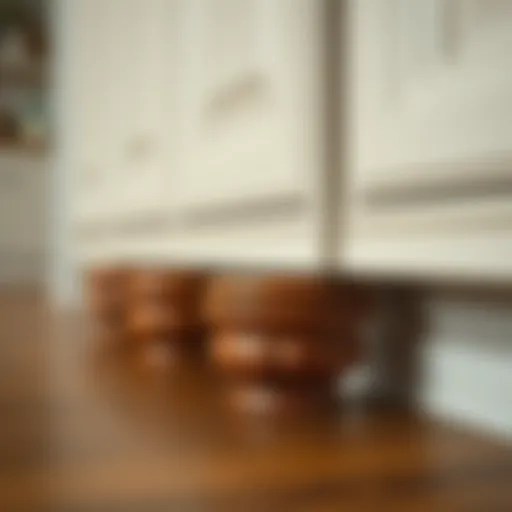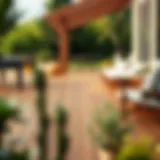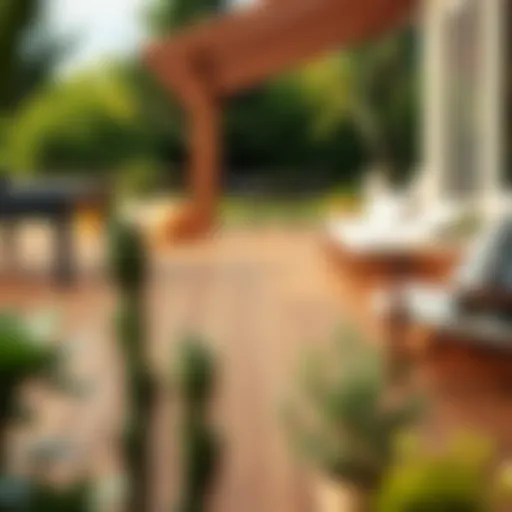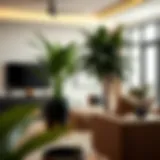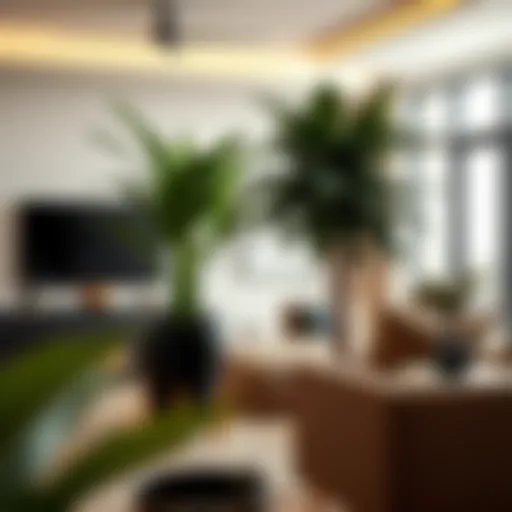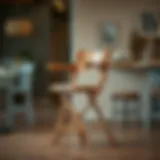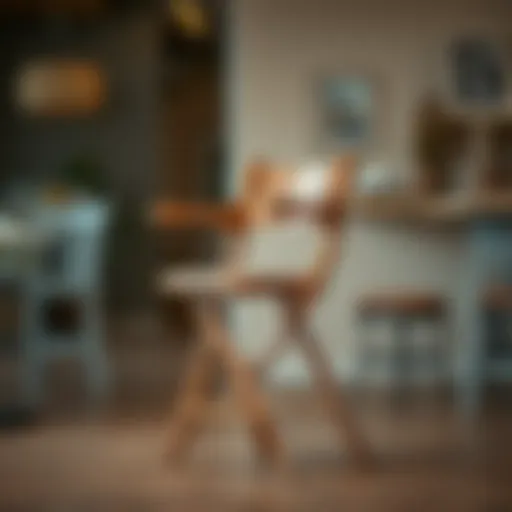Versatile Pouf Ottomans with Legs for Modern Spaces
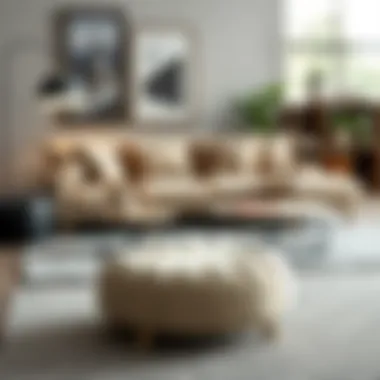
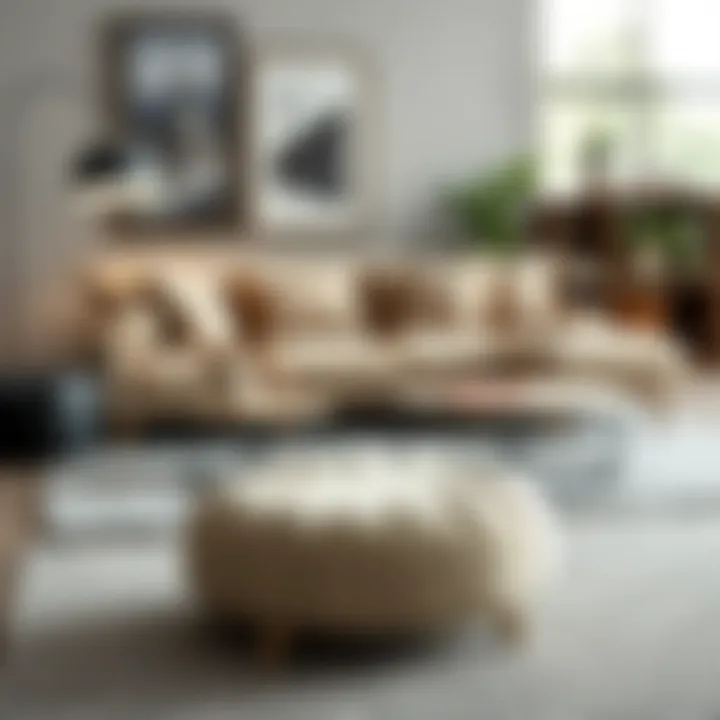
Intro
When it comes to home décor, pouf ottomans with legs often fly under the radar, yet they offer a remarkable blend of style and versatility. These chic pieces can do far more than just provide extra seating. With their growing popularity, understanding their practical applications and design potential becomes essential for homeowner and designer alike.
The beauty of pouf ottomans lies in how effortlessly they can complement various design aesthetics. Whether you lean towards minimalist styling or prefer bold, eclectic designs, these ottomans can adapt to suit your needs. They can serve as footrests, extra seating, or even side tables in a pinch. With this article, we aim to dive deeply into the world of pouf ottomans with legs, shedding light on their unique attributes and versatile applications.
Throughout the exploration, we'll discuss furniture design trends, essential buying guides, and delve into maintenance tips and DIY opportunities that allow you to tailor your pouf ottomans to your personal taste. You'll soon discover how these furnishings can elevate the aesthetics of your spaces while maximizing functionality. So, let’s roll up our sleeves and explore this underappreciated furniture piece that can breathe new life into your home.
Foreword to Pouf Ottomans with Legs
Pouf ottomans with legs have become a beacon of versatility in modern home décor. These furniture pieces embody practicality, stylishness, and adaptability all rolled into one. In today’s fast-paced world, where space can be a premium, poufs offer solutions that blend functionality with aesthetic appeal. Homeowners, designers, and DIY enthusiasts alike find their charm irresistible, as they can effortlessly shift from being a footrest to an extra seat or even a makeshift table.
The significance of pouf ottomans with legs extends beyond mere functionality. They come in a myriad of shapes, sizes, and styles, providing an endless array of options for personalization. Whether it’s a sleek leather accented piece in a contemporary setting or a cozy, fabric-covered design that complements a rustic theme, there’s likely a pouf that can fit right in.
Definition and Features
A pouf ottoman is typically defined as a padded, upholstered piece of furniture that serves multiple functions. Unlike traditional ottomans, poufs often lack hard edges and can be found in a softer, more rounded form, which enhances comfort and encourages a relaxed atmosphere.
When it comes to features, poufs with legs stand out from their legless counterparts. The inclusion of legs offers a unique mix of visual appeal and practicality. For instance:
- Support and Stability: The legs provide a stable base, allowing the pouf to hold weight better, which is useful when it doubles as seating.
- Versatile Application: They can also act as tables for small items, lending a touch of elegance to living spaces.
- Design Choices: These pieces come in various materials and colors, from the cozy feel of fabric to the sleekness of metal, which can suit diverse interior styles.
Historical Context
To appreciate the pouf ottoman with legs, it’s essential to look back at its roots. Originating from the Middle East, the concept of poufs has been a part of varied cultures for centuries. Historically, they were used as seating that promotes social interaction, placed around low tables during gatherings for storytelling or meals.
Over time, the advent of modern design concepts in the furniture world saw these pieces evolve. By incorporating legs into their designs, artisans responded to the rising demand for multifunctional and space-efficient furniture. This blend of traditional comfort with modern utility has positioned pouf ottomans with legs as a staple in homes today.
By understanding both the definition and historical significance, it’s clear that pouf ottomans with legs are not just furniture but also a reflection of lifestyle, culture, and the evolution of interior design.
Types of Pouf Ottomans with Legs
In any well-curated living space, the types of furniture used often speak volumes about one’s personal style, functionality desires, and overall design philosophy. Pouf ottomans with legs can bridge the gap between form and function, blending an array of styles to enhance both aesthetics and utility. When choosing a pouf ottoman, understanding the variety available can help homeowners, designers, and DIY enthusiasts make informed choices that elevate their interiors.
Modern Designs
When you think of modern pouf ottomans, sleek lines and minimalistic appeal come to mind. These designs often utilize geometric shapes and a variety of materials that evoke a sense of contemporary elegance. A modern pouf ottoman might sport a smooth leather finish or a well-tailored fabric in solid, muted tones.
The benefits of incorporating modern designs are many:
- Space Efficiency: Modern poufs are often designed to optimize space without cluttering it.
- Versatility: They can double as seating arrangements or serve as decorative elements.
- Trending Aesthetics: Modern poufs align with current trends, making them a popular choice among younger homeowners.
For example, a vibrant velvet pouf can add a pop of color to an otherwise neutral room, while a minimalist geometric pouf keeps things airy and open. Choosing the right modern design can significantly affect the perception of space.
Traditional Styles
Traditional pouf ottomans offer a sense of timelessness and craftsmanship that appeals to many. These designs often incorporate rich materials, intricate patterns, and classic color palettes that resonate with historical themes. They may feature sturdy wooden legs carved in ornate styles or heavy upholstery that speaks to artisanal quality.
Choosing traditional styles can provide:
- Heritage Appeal: These designs often have cultural significance and are perfect for heritage-inspired homes.
- Stability: Well-constructed traditional poufs are durable and provide substantial support compared to more modern counterparts.
- Comfort: Often padded with layers of cushioning, they provide a luxurious seating experience.
A floral-patterned pouf Ottoman can serve as a conversation starter while complementing vintage furniture beautifully, appealing to eclectic tastes.
Contemporary Variations
Contemporary pouf ottomans blend elements of both traditional and modern styles, creating a unique aesthetic that caters to varied consumer preferences. The variations might include bright colors, unique prints, and an array of materials that can easily adapt to any decor theme.
These poufs are particularly favored for:
- Innovation: They often incorporate modern functionalities like hidden storage or adjustable heights.
- Eclectic Choices: With a myriad of designs available, homeowners can express individuality while retaining cohesion in their decor.
- Affordable Style: Many contemporary options are budget-friendly, allowing multiple purchases without financial strain.
An example of a contemporary pouf might be a brightly patterned fabric pouf with metallic legs, providing both flair and functionality compared to traditional styles.
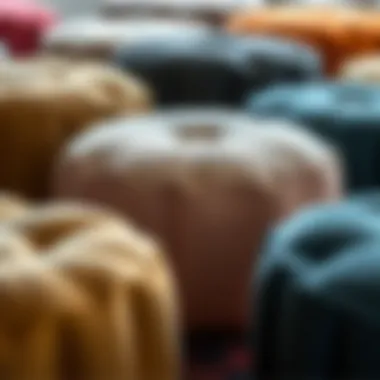
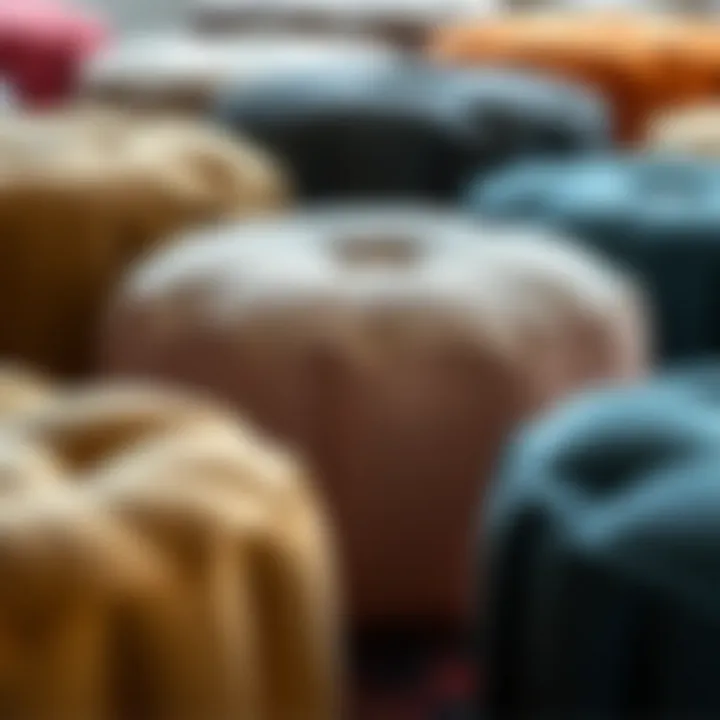
"The beauty of pouf ottomans lies in their ability to suit any decor style, whether you lean toward classic charm or cutting-edge modernity."
Choosing the right type of pouf ottoman with legs can enhance the overall design, create functional spaces, and reflect personal taste. By considering modern designs, traditional styles, and contemporary variations, individuals can find versatile pieces that resonate well within their homes.
Materials Used in Pouf Ottomans
When it comes to pouf ottomans with legs, the materials used are foundational to their design, practicality, and appeal. By exploring various fabric and structural choices, we not only uncover aesthetic possibilities but also reflect on durability and functionality. Crafting these pieces thoughtfully allows homeowners and designers to weave elegance with everyday use. Let's delve into the specifics, including fabric choices, leg materials, and the eco-conscious options now making waves in the furniture scene.
Fabric Choices
Cotton
Cotton is often the go-to for many interior designs, especially in pouf ottomans. Known for its breathability and ease of cleaning, cotton can handle the daily grind of family life. This fabric tends to come in a wide array of colors and patterns, offering flexibility for different design schemes. Its unique feature lies in its comfort—cool during summer and warm in winter. However, one downside is that cotton can be prone to fading when exposed to sunlight, so considering its placement is key.
Linen
Linen has a distinct texture that adds sophistication to pouf ottomans. Its natural fibers create a lightweight feel that contributes to a casual yet refined look. Notably, linen is biodegradable and has a long shelf-life, making it a sound choice for the environmentally conscious. Although it wrinkles easily and might not stand up to heavy stains, those who appreciate its aesthetic often find it worth the trade-off. The unique slubby weave of linen offers an effortless charm, perfect for laid-back settings.
Velvet
If you’re aiming for luxury, velvet is hard to beat. This fabric promises richness in both color and texture. Velvet poufs are often associated with opulence, fitting into spaces that call for a touch of glam. It’s soft against the skin and invites relaxation, which can be particularly appealing in living rooms. One caveat, however, is its maintenance; although many a velvet fabric looks striking, it can attract pet hair and dust more readily than other fabrics. A little extra care in cleaning goes a long way here.
Synthetic Fibers
Synthetic fibers, such as polyester and nylon, are becoming increasingly popular in pouf ottomans for their durability and resistance to wear and tear. These materials often replicate the softness of natural fabrics while being more stain-resistant and easier to clean. The trade-off is that they may not have the same luxurious feel as cotton or velvet. Still, synthetic options are a wise choice for families with young children or pets; they offer a practical solution without sacrificing style.
Wood and Metal Components
Leg Materials
Leg materials play a crucial role in the stability and style of pouf ottomans. Wood adds a classic touch, bringing warmth and a sturdy base to the piece. Different kinds of wood, like oak or walnut, can influence the ottoman's overall aesthetic, from rustic to modern. Meanwhile, metal legs introduce a touch of contemporary flair, often lending a sleek and industrial look. The unique feature of metal is its resilience under pressure, which can be particularly advantageous in high-traffic areas.
Stability and Support
Stability is paramount in any piece of furniture, and pouf ottomans are no exception. The right combination of leg materials and design ensures that the ottoman can withstand use as a footrest, seat, or even as a makeshift table. A well-designed base not only preserves functionality but also enhances safety, preventing unwanted tipping. It’s essential to consider the design of the legs; heavier ones generally provide better support, especially for multifunctional uses.
Sustainable Options
Recycled Materials
In an era of growing eco-awareness, utilizing recycled materials in pouf ottomans can be quite impactful. These materials reduce waste and environmental stress, making them an ideal choice for conscious consumers. By repurposing plastics or reclaimed wood, manufacturers are able to create products that not only look good but also do good. The unique aspect of this approach is that each piece tells a story of sustainability and care for our planet.
Eco-friendly Fabrics
Eco-friendly fabrics are making strides in the upholstery world. Materials like organic cotton or hemp are increasingly popular choices for those who want to ensure that their home décor is not harmful to the environment. They are often processed with minimal chemicals, which makes them a safer choice for homes with children or pets. One must keep in mind, however, that these fabrics may sometimes come at a higher price point, reflecting their sustainable sourcing practices. As more people recognize the benefits of eco-friendly options, they become a more prevalent choice in the market.
Functional Benefits of Pouf Ottomans
Pouf ottomans with legs offer a unique blend of practicality and style that makes them indispensable in modern interiors. Their multi-faceted nature allows homeowners to utilize them in various roles, catering to both aesthetic preferences and functional needs. Understanding the benefits of these versatile pieces can greatly enhance how you approach your own space planning and design.
Space-Saving Solutions
One of the standout attributes of pouf ottomans is their ability to save space. Unlike traditional furniture, which can often overtake a room, pouf ottomans are inherently compact, allowing them to fit neatly into smaller areas. They can be tucked under tables or used as makeshift seating when guests arrive, proving to be an excellent solution for city dwellers or anyone with limited square footage.
Furthermore, their lightweight nature means they can be easily moved around to accommodate various activities. Say you’re having friends over, and you need extra seating. Just grab the pouf and plop it down for a quick, no-fuss solution. In a crowded room, these poofs can slide away when not in use, allowing for a more open and spacious feel.
Versatile Uses
Seating Options
Seating is often the most obvious use for pouf ottomans. They serve as an adaptable solution for informal gatherings where traditional seating might be too rigid or formal. The soft structure of a pouf accommodates various sitting positions, which encourages relaxation. You can comfortably sit cross-legged or sprawl out, providing a more laid-back vibe to your living area.
- Key characteristic: Their casual appeal makes them perfect for lounging.
- Unique features: Unlike rigid chairs, they can offer a more inviting option for social gatherings.
- Advantages: They blend seamlessly into various decor styles, whether you're aiming for bohemian, modern, or even minimalist looks.
Coffee Table Alternatives
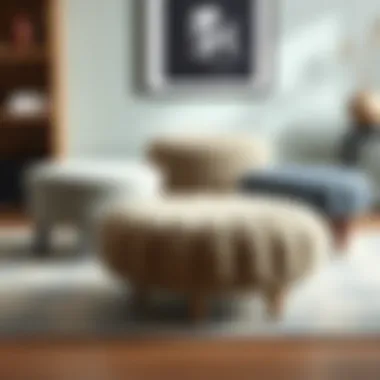
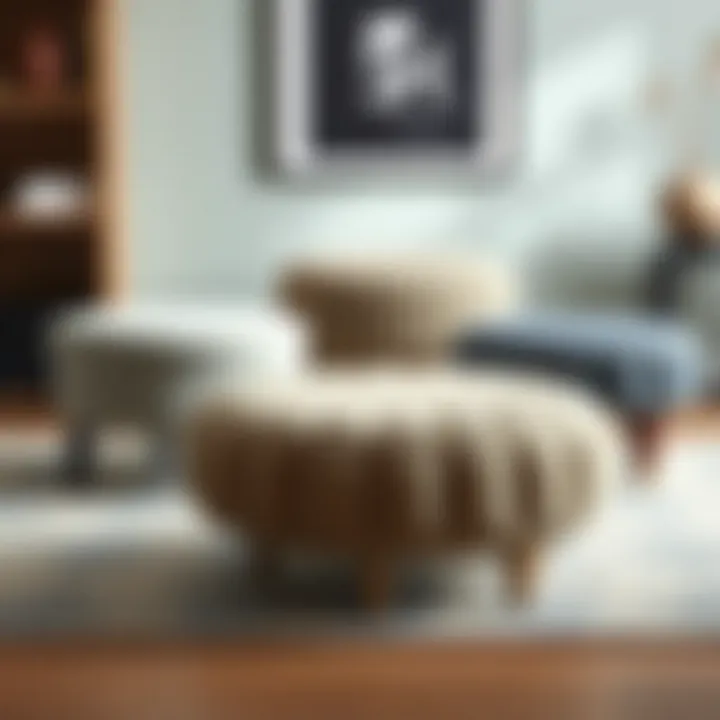
Pouf ottomans can also double as coffee table alternatives. They provide a soft surface for placing drinks, snacks, or books without the risk of sharp corners. This quality makes them particularly appealing in households with children or pets, where traditional tables can pose a hazard.
By using poufs in place of traditional coffee tables, you're not only adding a unique character to your space, but you’re also creating a more cohesive flow in an open-concept living area.
- Key characteristic: Their flexible use allows homeowners to adapt to their lifestyle needs.
- Unique features: Many poufs come in various fabrics and designs, enhancing the overall aesthetic.
- Advantages: They can multitask easily; let’s say you run out of space to serve snacks during a game night, simply use a pouf to hold the drinks and chips.
Footrests
Let's not overlook the often-underappreciated role of a pouf as a footrest. After a long day on your feet, kicking them up on a pouf can feel immensely satisfying. They provide the perfect height for elevating your legs, which can be both comfortable and beneficial for relaxation.
- Key characteristic: The soft cushioning makes them suitable for resting your feet after a long day.
- Unique feature: Some designs opt for added textures or patterns, making them a stylish addition while serving a functional purpose.
- Advantages: When you’re not using them as footrests, they can still be pulled into the mix as additional seating or tables when needed.
Integrating Pouf Ottomans into Your Space
When it comes to home décor, the interplay of style and functionality plays a pivotal role. Pouf ottomans with legs are not just trendy accessories, but they also serve multiple purposes. Integrating these versatile furniture pieces into your space requires thoughtful consideration. This section dives into choosing the right style, color and pattern choices, and placement strategies to maximize their aesthetic and functional potential.
Choosing the Right Style
Assessing your space starts with understanding your own design philosophy. Different styles of pouf ottomans include everything from minimalist to bohemian vibes. If your home features sleek lines and a modern aesthetic, a pouf with a geometric design might complement your surroundings.
- Modern: Look for clean lines and simple shapes. Think about poufs made of bold fabrics like leather or structured materials.
- Traditional: Opt for pieces that echo classic designs with rich textures, perhaps in deep upholstery colors.
- Eclectic: A mix-and-match approach works wonders here. Don’t shy away from vibrant patterns that can serve as conversation starters.
The goal is to ensure that the pouf ottoman not only fits into your current setup but enhances it. Experimenting with styles can breathe new life into your environment.
Color and Pattern Considerations
Selecting the appropriate color or pattern is crucial for visual harmony in your living space. Consider the dominant colors in your room and how a pouf can either complement or contrast these shades. A neutral-tone pouf can blend seamlessly, while a vibrant, patterned option can act as a bold focal point.
- Neutral Colors: Whites, beiges, greys can provide a serene backdrop and offer versatility over time.
- Vibrant Patterns: Floral or abstract designs can inject personality without overwhelming the overall décor.
Mix-and-match different fabrics and textures to create depth. Layers can transform a flat visual into something textured and inviting. Don’t forget to consider the mood you want to set; calming tones can create relaxation, while bold hues can stimulate energy.
Placement Strategies
Knowing where to place your pouf ottoman can make or break its functional promise. It’s about more than aesthetics; consider the flow of your living space. Common placements include:
- In Front of a Sofa: Acting as a coffee table alternative, this setup encourages interaction among guests.
- In a Reading Nook: As a footrest, it can balance comfort with style, inviting one to settle down with a good book.
- In a Hallway or Entryway: An ottoman can serve as a casual seating option for putting on shoes or gathering belongings before heading out.
To optimize space, keep it low-key and avoid overcrowding your area with too many pieces. Rule of thumb: leave enough room for movement; after all, no one wants to feel cramped in their own home.
Integrating pouf ottomans into your home isn't just about finding a piece you like; it's part of a larger puzzle that brings your decorating vision together. Keep your surroundings in mind, and these versatile pieces can surely enhance both function and design.
Care and Maintenance of Pouf Ottomans
Proper care and maintenance of pouf ottomans with legs can significantly extend their lifespan and keep them looking sharp. These versatile pieces often become focal points in living rooms or bedrooms, so ensuring they remain in top condition is essential. Regular maintenance not only preserves their aesthetic appeal but also contributes to a healthier home environment, free from allergens that could lurk in neglected upholstery.
Cleaning Techniques
Depending on the materials used, cleaning pouf ottomans may vary. Here are a few tailored techniques:
- Fabric Poufs: Start by checking the care label. Most fabric poufs can be vacuumed regularly to remove dust. If there's a stain, a gentle mixture of water and mild detergent usually does the trick. Use a soft cloth or sponge to dab the soiled area, but be careful not to soak it in water.
- Leather Poufs: These add a touch of elegance but can be a bit tricky. Clean them using a damp cloth followed by a dry one. For deeper stains, specialized leather cleaners should be employed. Remember to also condition them occasionally to prevent drying and cracking.
- Woven Poufs: Often made from natural fibers, these require a light vacuum and spot cleaning only. A fabric brush may help to lift dirt without harming the fibers.
"A little care goes a long way—instead of replacing worn-out ottomans, a little TLC can make them look new again."
Preventative Care
Engaging in preventative care can save time and money down the line. Here are some useful strategies:
- Placement: Ensure your pouf is not positioned in high-traffic areas if possible. This minimizes wear and reduces the chances of accidental spills.
- Use Protective Coatings: For fabric ottomans, consider applying a fabric protector spray designed for upholstery. This will help repel stains and make cleaning easier.
- Rotate Regularly: If your pouf is used frequently, consider rotating its position periodically. This ensures that one area doesn’t wear out faster than the other, particularly for poufs with a patterned fabric.
- Keep Away from Sunlight: Direct sunlight can cause fabrics to fade over time. Placing your pouf in a shaded area helps maintain its vibrant colors.
In summary, maintaining pouf ottomans with legs involves routine cleaning and implementing preventative strategies that protect your investment and ensure their longevity in your home. With a little effort and foresight, these pieces can provide functional beauty in your living spaces for many years.
DIY Pouf Ottoman Projects
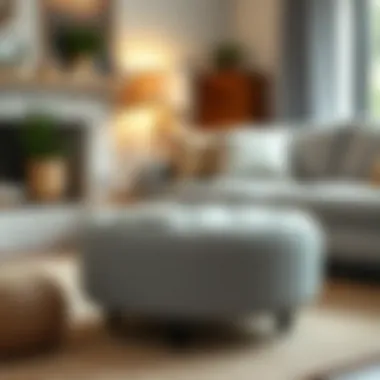
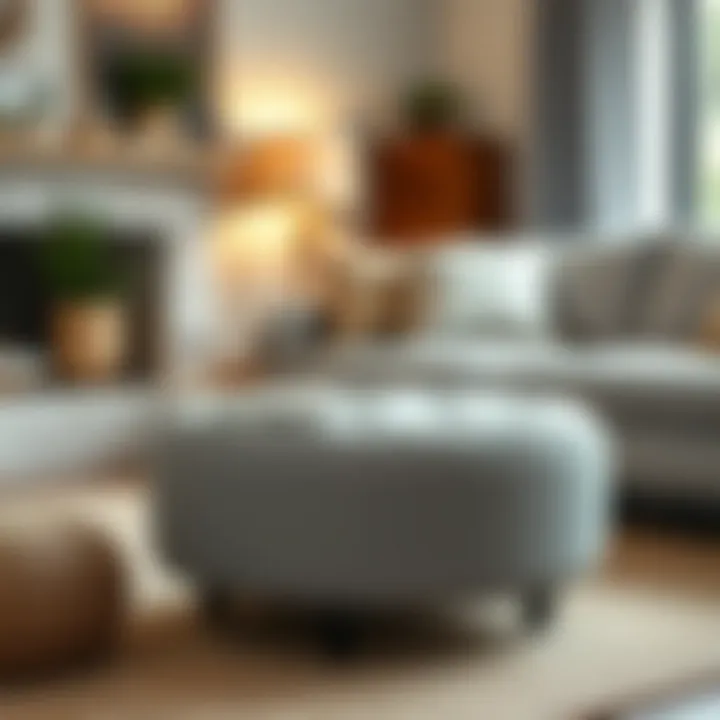
Creating your own pouf ottoman can be a fulfilling endeavor. It allows for personal expression and enables one to tailor the design to fit specific decor styles and colors in your home. The process of crafting a DIY pouf gives you flexibility that ready-made options often lack. You’re not just obtaining furniture; you’re gaining a unique piece that holds a story.
The importance of DIY pouf ottoman projects lies in their manifold benefits. Firstly, they encourage creativity. You can experiment with different shapes, fabrics, and uses—all of which can reflect your personal taste and style. Furthermore, hands-on crafting can be therapeutic. Many find satisfaction in constructing something of significance with their own hands.
There are also practical advantages. Making your pouf ottoman can be cost-effective. Purchasing pre-made options can sometimes burn a hole in your pocket, but you can often find materials on sale or repurpose existing items, thus keeping the impact on your wallet minimal.
Finally, these projects allow customizations regarding size and use. For instance, you might need a pouf for extra seating or just a decorative accent in the room. By going the DIY route, you can create exactly what you envision.
Step-by-Step Guides
Creating a pouf ottoman can be broken down into manageable steps. Here’s a simple guide to get you started:
- Choose a Design: Sketch your idea, considering the size and shape. Circular, square, or even more abstract shapes can be options.
- Gather Materials: Select your fabrics and stuffing materials. Old cushions or foam can serve as good stuffing. Don’t forget the legs, if your design includes them.
- Cut the Fabric: Measure and cut your fabric pieces according to the design. Ensure to leave extra inches for seams.
- Sew the Pieces Together: With your sewing machine or by hand, start stitching the pieces together, leaving an opening for stuffing.
- Stuff the Ottoman: Once you’re done sewing, fill the pouf with your chosen stuffing. Make sure it's packed evenly.
- Close the Opening: Hand-sew the last part of the pouf shut once it’s filled to your liking.
- Attach Legs: If your design includes legs, securely attach them in the designated spots.
This process is straightforward but can be adjusted based on individual needs—some may wish to include zippers for removable covers, while others may focus on purely decorative elements.
Material Sourcing and Budgeting
Finding the right materials for your DIY pouf ottoman is crucial and can influence both the look and durability of the final product.
Sourcing Materials
- Fabric: Look for upholstery fabric at local craft stores or online retailers. Consider checking out thrift stores for hidden gems or repurpose old cushions and clothes.
- Stuffing: As mentioned, repurposed items, like old pillows or foam, can serve well. If buying new, consider filling materials made from recycled products.
- Legs: Materials for legs can be found at hardware stores or online marketplaces. If you’re up for a challenge, you might even create legs from wood or metal, which can add a unique flair.
Budgeting Considerations
When setting your budget, it's essential to plan ahead. A rough outline might look like this:
- Fabric (per yard): $5-$20, depending on quality
- Stuffing: $10-$30 based on how much you need
- Legs: $10-$40, depending on material type
- Total Estimated Cost: Ranges from $35 to $90, which is significantly lower than many store-bought ottoman options.
By keeping an eye out for sales or seasonal discounts, you can save even more as you build your craft arsenal while embarking on your pouf project.
The Popularity of Pouf Ottomans with Legs
Pouf ottomans with legs have surged in popularity, carving a niche that beautifully intertwines functionality with aesthetic appeal in modern decor. Their rise can be attributed to several factors that resonate with both homeowners and designers. Today, these versatile pieces are more than mere furniture; they are potential style statements, space savers, and conversation starters.
Trends in Home écor
One cannot explore the landscape of contemporary home décor without acknowledging the shift toward multifunctional furniture. Pouf ottomans with legs fit seamlessly into this narrative by offering an effective solution for both small apartments and spacious homes alike. They serve various purposes—acting as footrests, additional seating, or even as compact coffee tables. As homeowners increasingly embrace minimalistic and multifunctional living, the versatility of poufs resonates with their desire for clever design.
Current trends shaping the fabric of these pieces include:
- Bold Patterns and Colors: Rich hues like deep teal or warm terracotta are gaining traction, transforming these ottomans into standout decor.
- Textural Diversity: From textured weaves to plush velvets, the tactile quality of material amplifies visual interest.
- Nature-Inspired Designs: Sustainability leads the charge, with many designers opting for eco-friendly materials. This not only reduces environmental impact but also appeals to a growing demographic of environmentally conscious consumers.
Influence of Social Media
Social media has drastically influenced home design trends over the past few years. Platforms like Instagram and Pinterest are teeming with posts showcasing beautifully styled interiors, often highlighting pouf ottomans as essential components. Cozy corner nooks or trendy lounge areas frequently feature these adaptable pieces, demonstrating their capacity to elevate a space. Additionally, hashtags such as #PoufLove or #OttomanGoals have garnered thousands of shares, cementing the pouf's status as a must-have.
The visual nature of social platforms allows for compounding effects; once a pouf captures the attention of an influencer, its popularity can spike overnight. This eagerness to adopt trending styles reflects a greater shift in the consumer psyche—a desire for on-trend yet functional furniture.
In summary, the growing affinity for pouf ottomans with legs can be attributed to their remarkable versatility and enhanced visibility through social media. As consumers become increasingly aware of how furniture impacts their lifestyle, the pouf's adaptability solidifies its place in both contemporary decor and day-to-day practicality.
Ending
In wrapping up our exploration of pouf ottomans with legs, it becomes clear how these versatile pieces of furniture offer a blend of style, functionality, and adaptability in modern home decor. Notably, they embody a balance between aesthetic appeal and practical utility. Their unique characteristics allow them to fit seamlessly into various interior styles, from contemporary to traditional, providing homeowners and designers with a plethora of options to choose from.
Summary of Key Points
To recap, the following elements highlight the significance of pouf ottomans with legs:
- Diverse Styles: These pieces come in a range of designs which cater to different tastes and preferences. From sleek, minimalistic forms to ornate patterns, they can either blend into a space or stand out as accent pieces.
- Functional Versatility: Beyond mere seating, pouf ottomans serve multiple roles, such as coffee tables or footrests, maximizing their utility in tight spaces.
- Material Choices: The variety of materials—from soft fabrics to sturdy woods—ensures that there's a pouf ottoman suitable for every lifestyle and aesthetic preference.
- Sustainable Options: The growing popularity of eco-friendly designs highlights a shift towards responsible consumerism, making these ottomans not only stylish but also environmentally conscious.
Each of these points demonstrates how pouf ottomans with legs are not just functional furniture but also pieces that contribute to the overall character of a room.
Final Thoughts
When integrating pouf ottomans into any space, consider both the visual impact and the practical aspects they offer. Their ability to adapt to changing needs—from extra seating during gatherings to a place for resting tired feet at day's end—is a testament to their multifunctionality. As you think about your home’s decor, remember that these pieces can be both stylish and pragmatic. Investing in pouf ottomans not only enhances your living environment but also affords you the flexibility to redefine how you use space. By thoughtfully incorporating them into your design, you create a cozy and inviting atmosphere, reflecting personal taste and functional needs. In a world where versatility matters, pouf ottomans with legs certainly take the cake.
"Furniture with purpose is not just about comfort; it's about storytelling and the experience it brings to our everyday lives."
Ultimately, these multifaceted pieces deserve a prominent place in your home, marrying style and substance in a way few others can.


